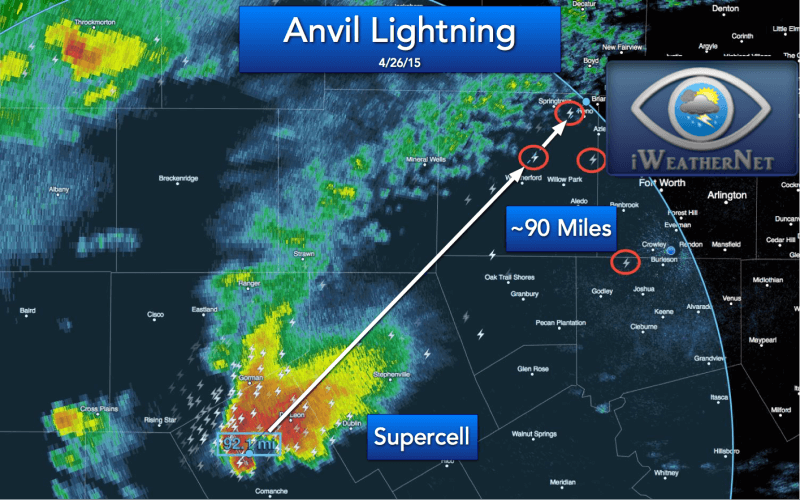While injury from lightning strikes has increased since 1940, fatalities have decreased dramatically. In fact, lightning deaths have become exceedingly rare relative to other weather phenomena, but they still occur. The most dangerous lightning strikes are those that occur when our guard is down; lightning strikes from a sky that appears to be clear and the nearest thunderstorm on radar is many miles away. This is called anvil lightning and has been referred to as “lightning from the blue.” Technically, that type of lighting isn’t “from the blue” at all (assuming “blue” is meant to suggest that the sky was cloud-free when the strike occurred). Rather, all lightning emanates from the clouds of thunderstorms. Most lightning strikes occur within or in very close proximity to the thunderstorm producing it; however, anvil lighting can occur dozens — even a hundred or more — miles away from the parent thunderstorm.
 Quick Lightning Facts
Quick Lightning Facts
- There is no such thing as “heat lightning”
- Calculating the time from lightning to thunder applies only to that one strike; it says nothing about the “distance to the storm”
- Anvil lighting can occur more than 100 miles from the parent thunderstorm

What is a Thunderstorm Anvil?
The anvil gets its name from a tool used for thousands of years — the blacksmith anvil. Smith anvils are very heavy blocks on which hot metals can be hammered into desired shapes. The classic thunderstorm typically acquires a shape similar to a blacksmith anvil, hence the shared name. All thunderstorms have an anvil, but not all thunderstorm anvils look the same.

When the air rising through the updraft of a thunderstorm encounters the tropopause (the level that marks the bottom of the stratospheric inversion) it loses its buoyancy and ceases to rise. The air is then forced to spread horizontally, generally downstream with the prevailing wind at that altitude forming the anvil cloud. Momentum can cause the updraft to briefly overshoot the tropopause creating a small bulge at the top of the thunderstorm, and it can also allow the anvil to back-build upstream against the prevailing wind; however, the portion of the anvil that back-builds is typically small in relation to the downstream spread, an amount inversely proportional to the prevailing wind at the tropopause. The weaker the upper-level winds, the further upstream the anvil can back-build.

During severe weather season, upper-level winds are quite strong, typically in the range of 100 to 150 mph, and can cause a thunderstorm anvil to spread hundreds of miles downstream. In this situation, anvil lightning can occur dozens of miles downstream of the parent thunderstorm updraft (“downstream” in this instance is defined by the direction of the prevailing upper-level winds and the direction of anvil spread; not necessarily the direction that the thunderstorm is moving). By contrast, if the upper-level winds are very weak, a thunderstorm anvil may appear to be nearly symmetric, encircling the top of the thunderstorm. The latter is typical of “airmass” thunderstorms that form from the afternoon heating of a very humid/tropical airmass, often seen in the summer months in the Southeastern United States.
Anvil Lightning: Lightning from the Blue
In this article, I wanted to use a real case from April of 2015, to show that lightning strikes can occur scores of miles away from the parent thunderstorm. This phenomenon is called “anvil lightning”, and it is the scientific reason behind the old cliché, “lightning from the blue”. Unfortunately, this type of lightning kills unsuspecting people on golf courses and area lakes because of a single lightning strike from little more than a thin cirrus shield above. Technically, the sky isn’t “clear” because there is cirrus anvil overhead, but the sky may appear bluish and the sun may be faintly visible. The deadly strike may be the one and only strike for miles, and rain may never even fall at that location — especially if the thunderstorm is 100 miles away as we see in the examples below.

How Far Away is the Thunderstorm?
Anvil lightning can occur at great distances from the parent thunderstorm. I have personally witnessed a nearby lightning strike with startling thunder that emanated from the anvil of a thunderstorm that was 130 miles away. I have scanned the formal literature and a common upper-limit is about 200 km (124 miles). In the images below, I estimated lightning 90 to 120 miles from their parent thunderstorms.
Anvils form when growing thunderstorms reach the tropopause. The tropopause marks the lower boundary of the stable stratosphere. If you are familiar with the term “capping inversion” (a layer of warm air aloft that inhibits or precludes thunderstorm formation), then you can think of the stratosphere as a cap which determines the height of the thunderstorm.
Tidbit: The depth/height of the stratosphere/tropopause are not constant. They vary from day to day, north-south, and seasonally. The height of the tropopause is lowest in the tropics and highest at the poles.
When a thunderstorm reaches the tropopause, the rising air has no where to go except horizontally. Anvil clouds spread most rapidly downstream with the prevailing wind in the upper troposphere, although they can spread upstream if the updraft is particularly strong and/or the prevailing upper-level winds are relatively weak (common during the summer). When there are calm winds in the upper levels, like we often have in the summer months, the anvil may spread out equally in all directions and only for a short distance from the updraft. This is a common characteristic of summertime single-cell/pulse thunderstorms (known by some as “airmass” thunderstorms).
Anvil lightning occurs when the updraft is vigorous and the winds at the tropopause are particularly strong. The updraft vigor helps electrify the storm, and the upper level winds send the electrified anvil scores of miles downstream. Anvil propagation is correlated with the velocity (speed AND direction) of upper-tropospheric winds (approximately 9 to 13 km altitude, or 300 to 150-hPa). The lightning itself is directly correlated with updraft strength/vigor which is further correlated with strong vertical shear in the lower levels and atmospheric instability (CAPE). Severe thunderstorms may create electrified anvils that remain electrified for many miles, and even for a while after the thunderstorm itself weakens. It’s easy to see how our ancestors could have concluded that the lightning came “from the blue”. Now, science shows us the truth.


Long-term Trend in Lightning Deaths (since 1940)
Lightning fatlities have been on the decline for the past 76 years. In 1940, lightning strikes accounted for over 70% of all storm-related fatalities. In 2015, only 5% of storm-related deaths were caused by lightning; 2011 saw a record low of 2%.
Thunder and Lightning Simulator
Note: The simulator may not display properly on small mobile devices.
Watch Out for those Lightning Bolts from the Anvil!
|
Lightning strikes can occur over 100 miles from the parent thunderstorm. Thunder is the sound wave produced by the rapid expansion of air caused by the extreme heat of a lightning flash. Use the mouse to position the person further (or closer) from the base of the storm. Note: The simulator may not display properly on small mobile devices. |
Simulator created by Tom Whittaker and Steve Ackerman
